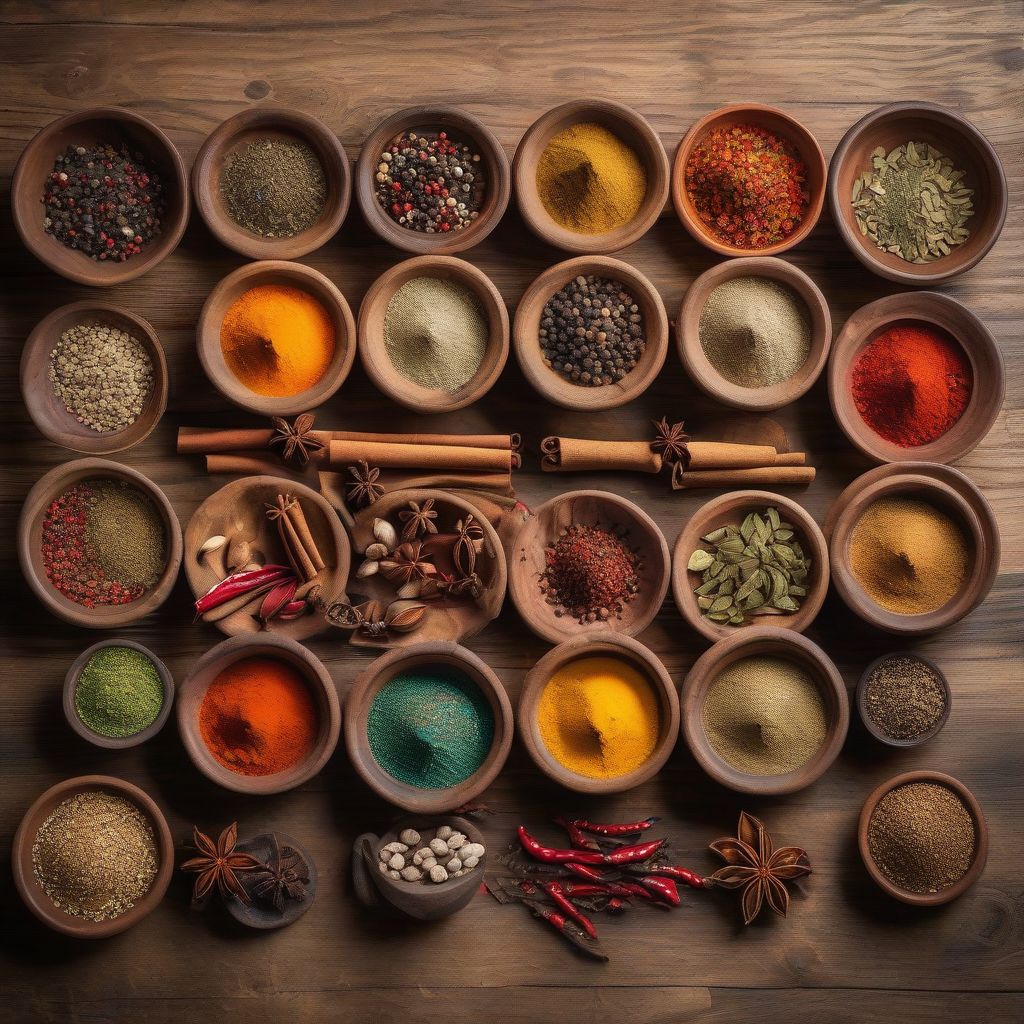Imagine biting into a juicy kebab, its smoky aroma filling your senses, or savoring the rich, complex flavors of a fragrant tagine. What is it about Middle Eastern cuisine that awakens the palate and leaves us craving for more? The answer, my friends, lies in the magic of herbs and spices.
As a nutritionist and meal prep coach, I’ve always been fascinated by the power of natural ingredients to elevate both the flavor and health profile of a dish. And when it comes to herbs and spices, Middle Eastern cuisine stands out as a shining example of culinary artistry.
A Symphony of Scents and Flavors: Exploring the Significance of Herbs and Spices
In Middle Eastern cooking, herbs and spices are not mere afterthoughts; they are the very essence that transforms ordinary ingredients into extraordinary culinary experiences. Beyond their flavor-enhancing properties, these aromatic wonders also boast a rich history intertwined with ancient traditions, medicinal uses, and cultural significance.
A Legacy of Flavor: Delving into the History
The use of herbs and spices in the Middle East can be traced back thousands of years. This region, historically a crossroads of trade routes, became a melting pot of culinary influences, with each culture leaving its mark on the region’s evolving flavor palette. From the ancient Sumerians who used coriander and cumin to the Persians who prized saffron, the history of herbs and spices in Middle Eastern cooking is as rich and diverse as the region itself.
Beyond Flavor: Unveiling the Health Benefits
Many Middle Eastern herbs and spices are revered not only for their flavor but also for their medicinal properties. Turmeric, with its vibrant yellow hue, is a potent anti-inflammatory, while cinnamon is known to help regulate blood sugar levels. Fresh herbs like mint and parsley aid digestion and provide a refreshing counterpoint to richer dishes.
 Middle Eastern Spices in Bowls
Middle Eastern Spices in Bowls
A Journey Through the Spice Bazaar: Key Herbs and Spices in Middle Eastern Cooking
Let’s embark on a sensory journey through the vibrant world of Middle Eastern herbs and spices. Get ready to discover the unique characteristics and culinary uses of these aromatic treasures:
1. Zesty Sumac: A Tangy Delight
Think of sumac as the Middle Eastern answer to lemon zest. This reddish-purple powder, derived from dried berries, adds a tart, lemony flavor to marinades, dressings, and dips.
Expert Tip: Sprinkle a dash of sumac over hummus for a vibrant flavor boost.
2. Earthy Cumin: A Warm Embrace
Few spices are as synonymous with Middle Eastern cuisine as cumin. This earthy, slightly bitter spice adds depth and complexity to meat dishes, stews, and vegetable preparations.
Culinary Inspiration: Cumin is a key ingredient in many spice blends, including baharat, a fragrant mix used in various savory dishes.
3. Aromatic Cardamom: A Sweet Seduction
Cardamom, with its intense, sweet, and slightly floral flavor, is a prized spice in Middle Eastern desserts and beverages. It also adds a luxurious touch to savory dishes, particularly those featuring lamb or chicken.
Did You Know? Cardamom is one of the most expensive spices in the world, often referred to as “Queen of Spices.”
4. Fragrant Saffron: A Golden Touch
Saffron, with its distinct aroma and vibrant color, is a true culinary treasure. This precious spice, derived from the stigma of a crocus flower, is used sparingly to impart a luxurious golden hue and a slightly bitter, floral flavor to rice dishes, desserts, and beverages.
Traditional Use: Saffron is a key ingredient in many Middle Eastern sweets, including the Iranian saffron ice cream, bastani.
5. Versatile Parsley: A Refreshing Burst
Fresh herbs play a vital role in Middle Eastern cuisine, and parsley reigns supreme. Its bright, slightly peppery flavor adds a refreshing touch to salads, dips, and meat dishes.
Culinary Tip: Combine finely chopped parsley with bulgur, mint, and tomatoes to create tabbouleh, a refreshing and flavorful salad.
Mastering the Art: Incorporating Herbs and Spices Like a Pro
Ready to unleash your inner chef? Here are some tips for using Middle Eastern herbs and spices like a seasoned pro:
- Toasting for Enhanced Flavor: Toasting whole spices before grinding them releases their aromatic oils, resulting in a more intense flavor.
- Balancing the Flavors: Middle Eastern cuisine is all about achieving a harmonious balance of flavors. Experiment with different combinations of herbs and spices to create unique flavor profiles.
- Fresh is Best: Whenever possible, opt for fresh herbs over dried ones for a more vibrant flavor.
- Start Small: When using a new spice, start with a small amount and gradually add more to your liking.
- Don’t Be Afraid to Experiment: The beauty of cooking is in the experimentation. Don’t be afraid to try new combinations and create your own signature dishes.
[amazon bestseller=”middle eastern cookbook”]
A Celebration of Flavor: The Enduring Allure of Middle Eastern Cuisine
From the fragrant spice markets of Istanbul to the bustling kitchens of Beirut, herbs and spices are the heart and soul of Middle Eastern cooking. They add depth, complexity, and a touch of magic to every dish, making this cuisine a true celebration of flavor.
So, embrace the aromatic allure of Middle Eastern herbs and spices and embark on a culinary adventure that will tantalize your taste buds and nourish your body.
What are your favorite Middle Eastern herbs and spices? Share your culinary adventures and recipe ideas in the comments below! Let’s inspire each other to explore the world of flavor, one spice at a time.
